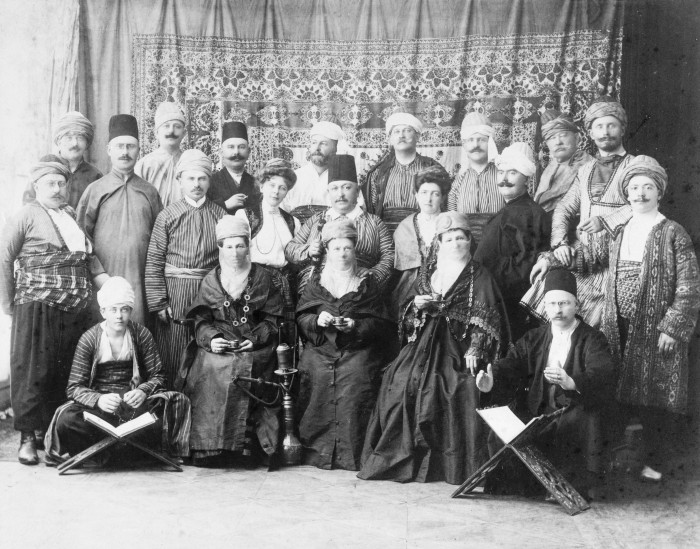German tourists in Ottoman costumes
 Tourists posing in Sultanahmet square. 1920s, Glass negative Suna and İnan Kıraç Foundation Photography Collection
Tourists posing in Sultanahmet square. 1920s, Glass negative Suna and İnan Kıraç Foundation Photography Collection
Travellers tend to consider themselves as big adventurers these days. Especially Europeans heading East can tell stories over stories about their journeys and all the differences they are facing away from home. But what must it have been like to take a big journey without just leaning back in a comfortable plane seat, without a Lonely Planet in your waterproof backpack and without the deseperate need of a selfie-stick? The exhibition Journey to the Center of the East at Istanbul Research Institute is depicting the rising of the mythical destination Constantinople beginning in the 1850’s.
There they are, standing on board of a Bosphorus cruising ship. Men are wearing suits and hats, women are dressed with long, wide skirts and flouncy blouses. One of them is looking into the camera, others are fascinated by Rumeli fortress to their right. It is somewhen in the 19th century and the people in the pictures are some of the first tourists in Istanbul. While their forerunners mostly came either for professional reasons such as trading or evangelizing or for researching purposes, the ones depicted at „Journey to the Center of the East 1850-1950 – 100 Years of Travelers in İstanbul from Pierre de Gigord Collection“ are on leisure time trips.
They followed a myth arising in Central Europe, which painted the Levante in shiny colours. The image created by the previous generation of travellers featured fantastic impressions as the Sultan’s harem, the whirling dance of the dervishes, female beauties hidden behind veils, water pipes, carpets and stray dogs. The combination of these mysterious aspects lead to a wave of Orientalism befalling European countries. As the exhibition displays, theatre shows in Paris and London rose, novels were written and travel guides established. Colourful advertisment posters of travel companies show Istanbul romanticized in sunset, mostly featuring the silhouette of Sultanahmet Mosque or relaxed beauties on carpets.
[widgetkit id=18777]
But already making their way to magical Constantinople was a big part of the adventure. The first tourists had to choose between ship or train, when train company Wagon-Lits for the first time added some luxury waggons to existing goods trains. The demand rose and so Wagon-Lits finally established the legendary Orient Express in 1883. The train itself became a place of yearning for Europeans as a narrow spot of social diversity and flagrant promiscuity. At Istanbul Research Institutes exhibition there are photos, newspaper articles, billets, luggage tags and menus giving an idea of the more than 67 hours lasting train ride from Paris to the Bosphorus. And as if this journey was not crazy enough yet, there were already in this time people who would be considered as extreme athlets today: In 1902 Albert Borchart for example walked all the way from Paris to Istanbul – 6784 kilometres in 183 days.
Co-curated by Ekrem Işın and Catherine Pinguet the exhibition „Journey to the Center of the East“ manages to enfold an exciting chapter of European-Ottoman cultural history. There is one section dealing with the sudden rise of grand hotels such as Pera Palace and Bristol Hotel (today’s Pera Museum) in the by then in vogue districts of Istanbul, and other pieces are dedicated to tourists placing themselves into the cityscape. It is an interesting exhibition giving insights to stereotypes and expectations of adventures attached to travelling already in those times, where no one wanted to buy selfie-sticks yet.
“Journey to the Center of the East 1850-1950” at Istanbul Research Institute (Meşrutiyet Caddesi No.47, 34443 Tepebaşı – Beyoğlu/İstanbul) until 17th of October, Monday-Saturday 10 a.m. to 7 p.m.
[widgetkit id=18781]

